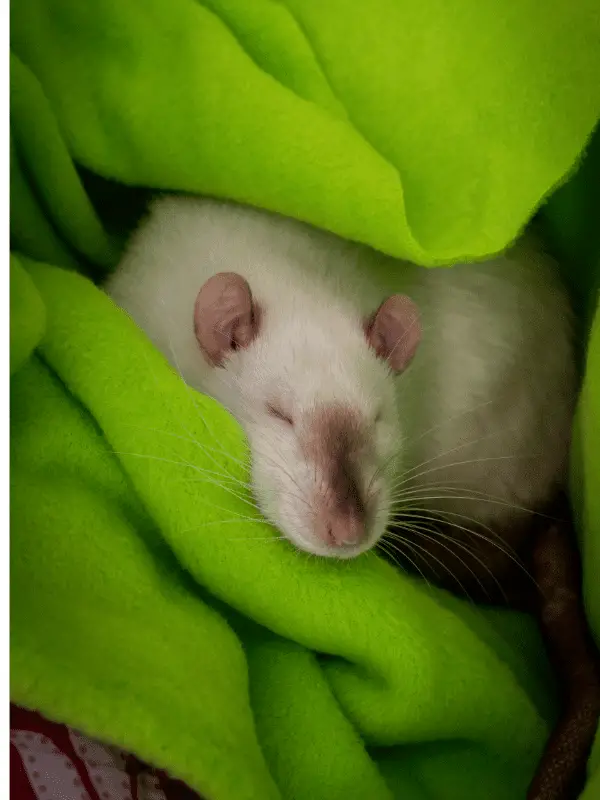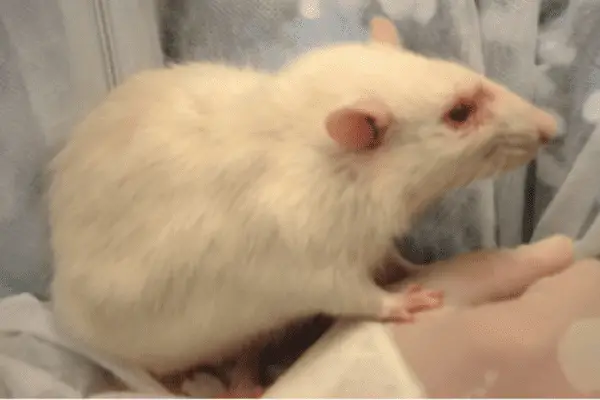This article contains affiliate links, and we may earn a commission at no cost to you if you choose to purchase through these links. I never recommend products that I do not trust or will not advise my veterinary clients and patients to use.
In a study by Roughan and Flecknell (2005), experienced rat owners or handlers, even veterinary staff, had difficulty identifying rats experiencing pain. They could not correctly identify rats that had pain medication before a surgical procedure versus rats that did not receive pain medication before a surgical procedure. However, after a brief training on rat behavior, they could correctly identify the group that did not receive pain medication with much more accuracy. This shows that even those familiar with rats may not identify signs of pain at first glance. We can all do with a bit of sharpening up when it comes to identifying pain in rats!
Rats experiencing pain will show changes in behavior such as reduced activity, appetite, and unusual aggression. Changes in the facial expression of rats such as slanted eyes, folded ears, and flattened cheeks with whiskers pointing away from the face (The Rat Grimace Scale Soticina et al. (2011)).
You can help a rat experiencing pain by keeping it in a comfortable, quiet, and dark environment with easy access to food and water. In addition, certain medications such as pediatric Acetaminophen (Tylenol) and Ibuprofen (Advil) elixirs can be given at specific safe dosages. If you think your pet rat is in pain, it is important to seek veterinary attention as soon as possible.
Rats are notoriously good at hiding signs of pain. As a prey species, their survival out in the wild depends on this because showing signs of pain will make them seem more vulnerable to predators. Therefore, as a rat owner, it is crucial to recognize the very subtle signs of pain in rats. In this article, I will explain all the signs and symptoms of pain, as well as a few remedies you may try to help alleviate your rat’s pain at home if you are unable to get your rat to a vet.
With that being said, if your rat exhibits any of the symptoms mentioned below, please get them to a vet as soon as possible to ensure that the underlying cause is addressed and to avoid unnecessary discomfort to your rat.

In this article, I have linked many other articles on this website that will help guide you to caring for your rat and understanding what is normal and what is abnormal for your rat. I hope that this will help you give your rat or rats the healthiest, most comfortable life you can.
Signs of Pain in Rats
The symptoms mentioned below are not exclusively signs of pain but can also indicate other medical conditions that may not necessarily be painful. However, if you notice any of the symptoms mentioned below, it is important to get your rat to a vet as soon as possible. If you would like to read more on knowing when to take your rat to the vet, look at this article.
1. Changes in Activity Level
This can be of sudden onset or can happen over the course of a few days. For example, if your rat seems less active or not interested in exploring when you allow supervised time outside the cage, it could be a sign of pain or lethargy.
If your rat suddenly does not want to come when called or avoids your hands, they may be experiencing pain. Likewise, if they shy away from activities that they used to enjoy, you need to be on the lookout for any concurrent symptoms such as the ones listed below.
2. Reluctance to Eat or Refusal to Eat or Drink
Rats are extremely food-driven. A healthy and happy rat will not decline a tasty food treat. If your rat is refusing their favorite treat or has gone a whole day without touching its food or water, it is cause for concern.
Reduced appetite is often one of the first symptoms of illness of any kind in rodents. Therefore, if you notice a reduced appetite, it is time to check for concurrent symptoms and clues to what may be causing them not to want to eat.
3. Unusual Aggression
Rats that are experiencing pain may uncharacteristically bite when picked up or lash out at cagemates that they used to get along with.
Sometimes it is quite obvious that they are reacting out of pain. For example, you accidentally touched a tender spot on their body. Other times it may be less obvious. Rats experiencing chronic pain or visceral (abdominal or organ pain) may just appear to be generally grumpier than usual.
4. Rough or Unkempt Coat
Rats experiencing pain may stop grooming themselves. For example, a rough-looking rat with dirty ears and face may just be too painful to balance on 2 or 3 feet to be able to clean their face and ears.
One never notices how much gunk can gather in a rat’s ears until they stop cleaning their ears! Unfortunately, we often see this as one of the signs in older rats suffering from arthritis or neurodegenerative conditions.
5. Porphyrin Staining Around The Eyes
Rats have a tear gland behind their eyes (the Harderian Gland) that tends to increase tear production when a rat is ill or stressed and contains a compound called porphyrin. When this compound reacts with UV light, it creates a brown discoloration that will stain the fur.
Porphyrin staining may be normal in geriatric rats. Still, if you notice that your rat suddenly has this discoloration around its eyes, it may be an indication of pain or illness.

6. Changes in Facial Expression – The Rat Grimace Scale
The Rat Grimace Scale was the product of research by Sotocina et al. (2011) to find a quantifiable, objective way to measure pain in lab rats. They were able to identify certain facial expressions associated with pain or discomfort in rats, and if you know what to look for, you will be able to recognize the subtle signs of pain in your rat.
The following facial features can indicate pain in rats:
- Tightening of they skin around the eyes, making the eye appear more slanted in stead of wide open and relaxed as would be seen in a happy rat.
- Flattening of the cheeck so that the seperation between the whisker pad and the cheek is almost indistiguishable.
- Folding of the ear. In stead of a round ear shape in comfortable rats, a rat in pain will almost fold their ears to have a pointed shape.
- Whiskers pointing away from the face. In stead of caarrying their whiskers in a relaxed postition next to the face, the whiskers may be pulled forward to almost be in a right angle to the cheek.

7. Writhing or Twitching
Writhing or twitching may go hand in hand and refers to a rat almost appearing as if they are sucking in their abdominal muscles. This may be in a twitching fashion or by constantly tightening the muscles. You can identify this as a hollow in your rat’s flank just behind the rib cage that a relaxed and comfortable rat does not have.
Twitching can be seen of the abdominal muscles, ears, or other body parts and may indicate pain.
Below is a handy downloadable poster on signs of pain in rats by the University of Michigan.
8. Increased Heart Rate or Respiratory Rate at Rest
This can indicate many different things, so context is crucial. In the absence of any other obvious symptoms of disease or causes of stress, increased breathing rate at rest may indicate pain, among other things.
Very vague, I Know. But if you would like to read more on how to check your rat’s vital signs at home, have a look at this article for details on all the normal physical parameters for rats. Knowing the normal will help you to be able to identify early signs of disease easily.
I Can’t Take My Rat to A Vet Immediately. What Can I Do At Home To Alleviate Pain?
Try to keep them as comfortable and calm as possible. Provide a safe environment with easy access to water and palatable food. You can give certain pediatric pain medication at specific doses – you can find more details in the table below.
1. Provide A Warm, Comfortable and Quiet Environment
Reduce the necessity to move around by providing your rat with easy access to water bowls and easy-to-eat food they enjoy. Food options for ill rats can include banana slices, baby puree, yogurt, or anything that does not require a lot of chewing or them holding it.
Provide soft absorbable bedding. Be ready with a change of clean bedding if they do soil their bedding due to reluctance to move.
The ideal room temperature for rats is around 70-75°F (20 – 25°C). Reducing any temperature challenge will help keep them comfortable.
I go into more depth on the above-mentioned points in my article on how to care for a frail pet rat. All the points discussed in that article can be applied to caring for a rat experiencing pain.
2. Keep Them Calm
Knowing what causes stress to your rats and what you can do to alleviate stress will aid in keeping them as comfortable as possible when they are experiencing pain. In the article I wrote on this topic, you can read more in-depth about what may cause stress in pet rats, the symptoms of stress, and what you can do to alleviate stress.
In addition to a comfortable environment, calming products such as Rescue Remedy or Pet Remedy, you can use music and low light to help keep your rat calm. If you would like to read more about these topics, have a look at this article looking at the research on the benefits music has on rats and this article on how light affects rats.
To help keep your rat calm, avoid bright light and loud noises. Instead, keep them in a quiet, dimly lit room and consider playing soft classical music. I discuss these topics in-depth in the two articles linked above.
3. Pain Medication – Important Notes
It is imperative to weigh your rat accurately and make sure you can calculate a dose correctly. It is very easy to accidentally overdose such small animals, which can have serious consequences. If your rat is overweight, do not use their current body weight to calculate the dose of medication; use their ideal body weight. Using the weight of an obese rat to calculate a dose can lead to overdosing and potential side effects from the medication. Remember: first, do no harm!
You can dilute medication into drinking water; however, dosing will not be accurate, and some rats may reject drinking water containing medication due to altered taste. Therefore, I recommend giving oral medication using a syringe. Take care only to give a drop or two at a time to allow the rat to swallow. Never try to give oral medication to a rat who has altered mentation and may be unable to swallow.
Never use more than one non-steroidal anti-inflammatory drug concurrently and never give non-steroidal anti-inflammatories (NSAIDs) concurrently with steroidal anti-inflammatories (corticosteroids) as both of these classes of drugs will lead to side effects such as gastric ulceration, kidney damage, and gastric upset. By using more than one drug from these classes, you will compound the side effects that can have fatal consequences, especially in a frail rat. Please consult your vet before giving medication to your rat.
Do not combine pain medication without consulting your vet.

What Pain Medication Can I Give My Rat?
This formulary table is only to be used in emergency and unusual circumstances where you cannot get veterinary attention for your rat. Please consult your vet if you think your rat might be in pain.
To calculate the dose, multiply the weight by the dose. To calculate the amount of medication needed, take the calculated dose and divide it by the concentration of the medication. Remember to check that all your units are correct. If this all sounds new and confusing, have a look at the Omni Calculator to help you with this.
All the dosages below are for oral dosing.
| Drug | Drug Class and effect | Dose | Dosing tips | How Often |
| Acetominophen/ paracetamol | Non-steroidal anti-inflammatory, pain relief | 100 mg/lb 100-300 mg/kg | The Children’s Tylenol Elixir is 32 mg/ml. You can dose this at 0.15 ml per 25 g body weight. | Can be given every 4 hours. |
| Aspirin | Non-steroidal anti-inflammatory, pain relief, inhibits blood platelet aggregation | 45 mg/lb 100 mg/kg | Do not give for one week prior to surgery or in cases of liver disease or bleeding disorders. | Can be given every 4 hours. |
| Carprofen | Non-steroidal anti-inflammatory, pain relief, long-lasting (12-24 hours) | 1-2 mg/lb 2-5 mg/kg | When using the 50mg/ml injectable formulation (dog and cat formulation – Rimadyl), dilute 0.1 ml in 3.9 ml sterile water/saline. This will give you a dilution with a 1.25 mg/ml concentration, which can be given at 0.1 ml per 25g body weight. | Give once daily. |
| Codeine | Opioid- pain relief and cough suppressant | 25-90 mg/lb 10-40 mg/kg | Often in elixirs with acetaminophen (check the active ingredients of pediatric pain elixirs) and can be given according to the acetaminophen dose of 0.15 ml per 25 g body weight. | Can be given every 4 hours. |
| Diclofenac | Non-steroidal anti-inflammatory, pain relief | 25 mg/lb 10 mg/kg | Not a drug of choice. Safety is not as clearly established as other Non- steroidal anti-inflammatories. | Single-dose only. |
| Ibuprofen | Non-steroidal anti-inflammatory, pain relief | 4-10 mg/lb 10-30 mg/kg | The Children’s Advil Elixir is 40 mg/ml and can be given at 0.02 ml per 25 g body weight. | Can be given every 6 hours. |
| Meloxicam | Non-steroidal anti-inflammatory, pain relief, long lasting (12-24 hours) | 0.3 – 0.9 mg/lb 0.5 – 2 mg/kg | Oral dog and cat formulations available with a 0.5mg/ml or 1.5 mg/ml concentration. The 1.5mg/ml formulation can be given at a 0.02 ml/25 g body weight dose. | Give once daily. Use the lower dose if needs to be given chronically. |
| CBD | Cannabidiol | Hemp Oil by PG Pets can be given at a dose of 2 drops per rat once per day. | The evidence for CBD is still somewhat anecdotal. Monitor closely for side effects. It May help in cases of chronic pain. | Give once daily. |
Below is a video tutorial on how to give oral medication to your rat. Remember to double-check your dose before giving the medication and give small amounts at a time to allow them time to swallow the medication.
Do not give oral medication if your rat is unresponsive or has altered mentation as they might not be able to swallow and your rat will be at risk for developing potentially fatal aspiration pneumonia.
Conclusion
This article aims to equip you as rat owner to be better able to identify pain in your rats and give you a few tools to use in emergency cases. Getting your rat to a vet ASAP is not always possible but should always be your first option.
References
- Banks, R., 2013. Exotic small mammal care and husbandry. Hoboken: John Wiley, pp.81 – 92. https://onlinelibrary.wiley.com/doi/book/10.1002/9781119265405
- Gonzalez MI, Field MJ, Bramwell S, McCleary S, Singh L. Ovariohysterectomy in the rat: A model of surgical pain for evaluation of pre-emptive analgesia? Pain. 2000;88(1):79–88. https://pubmed.ncbi.nlm.nih.gov/11098102/
- ILAR Journal, 1991. Recognition and Alleviation of Pain and Distress in Laboratory Animals. 33(4), pp.71-74. https://www.ncbi.nlm.nih.gov/books/NBK4032/
- Meredith, A. and Redrobe, S., 2002. BSAVA manual of exotic pets. 4th ed. Quedgeley: British Small Animal Veterinary Association, pp.13 – 25. https://www.researchgate.net/publication/240493099_The_BSAVA_Manual_of_Exotic_Pets_4th_edn
- Morton DB, Griffiths PH. Guidelines on the recognition of pain, distress and discomfort in experimental animals and an hypothesis for assessment. Vet Rec. 1985;116(16):431–436. https://pubmed.ncbi.nlm.nih.gov/25144086/
- O’Malley, B., 2005. Clinical anatomy and physiology of exotic species. Elsevier, pp.209 – 225. https://www.sciencedirect.com/book/9780702027826/clinical-anatomy-and-physiology-of-exotic-species
- Roughan JV, Flecknell PA. Training in behaviour-based post-operative pain scoring in rats—An evaluation based on improved recognition of analgesic requirements. Appl Anim Behav Sci. 2006;96(3–4):327–342. https://www.sciencedirect.com/science/article/abs/pii/S0168159105001589
- Shah J, Mason WD. Pharmacokinetics of codeine after parenteral and oral dosing in the rat. Drug Metab Dispos. 1990 Sep-Oct;18(5):670-3. PMID: 1981718. https://pubmed.ncbi.nlm.nih.gov/1981718/
- Sorge, R., Martin, L., Isbester, K., Sotocinal, S., Rosen, S., Tuttle, A., Wieskopf, J., Acland, E., Dokova, A., Kadoura, B., Leger, P., Mapplebeck, J., McPhail, M., Delaney, A., Wigerblad, G., Schumann, A., Quinn, T., Frasnelli, J., Svensson, C., Sternberg, W. and Mogil, J., 2014. Olfactory exposure to males, including men, causes stress and related analgesia in rodents. Nature Methods, 11(6), pp.629-632. https://www.nature.com/articles/nmeth.2935
- Sotocina, S., Sorge, R., Zaloum, A., Tuttle, A., Martin, L., Wieskopf, J., Mapplebeck, J., Wei, P., Zhan, S., Zhang, S., McDougall, J., King, O. and Mogil, J., 2011. The Rat Grimace Scale: A Partially Automated Method for Quantifying Pain in the Laboratory Rat via Facial Expressions. Molecular Pain, 7, pp.1744-8069-7-55. https://journals.sagepub.com/doi/full/10.1186/1744-8069-7-55
- University of Colorado, Denver, Anschutz Medical Campus, CU Denver Veterinary Formularly 4.3. https://www1.ucdenver.edu/docs/librariesprovider148/orcs_documents/cu-denver-veterinary-formulary-4-3.pdf?sfvrsn=6a6136b9_0
- Wright-Williams SL, Courade JP, Richardson CA, Roughan JV, Flecknell PA. Effects of vasectomy surgery and meloxicam treatment on faecal corticosterone levels and behaviour in two strains of laboratory mouse. Pain. 2007;130(1–2):108–118. https://pubmed.ncbi.nlm.nih.gov/17196337/

